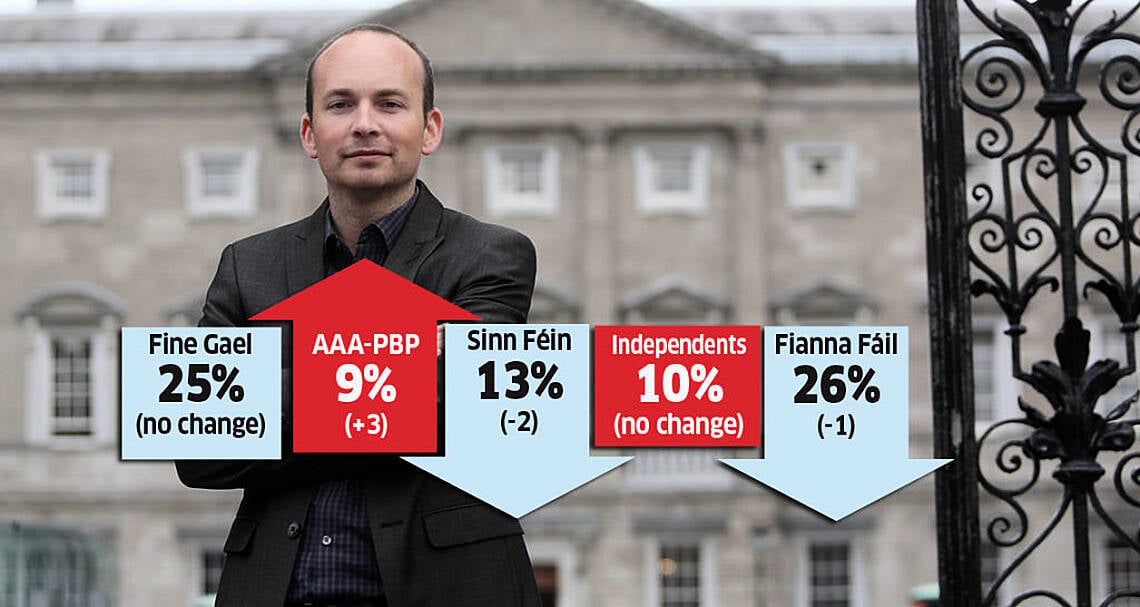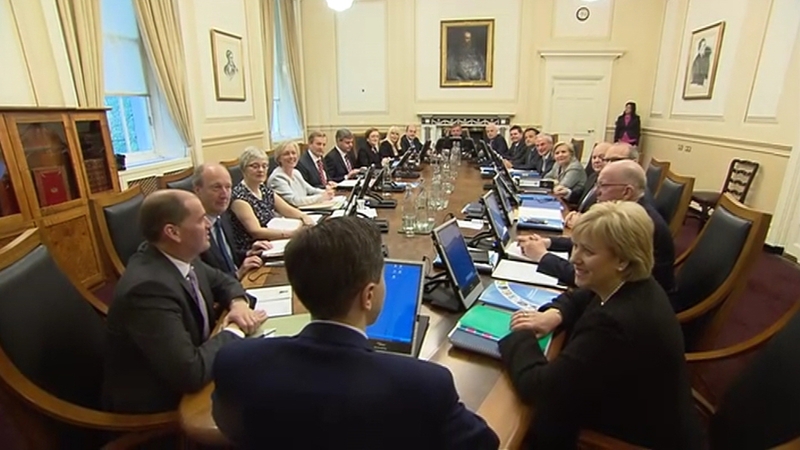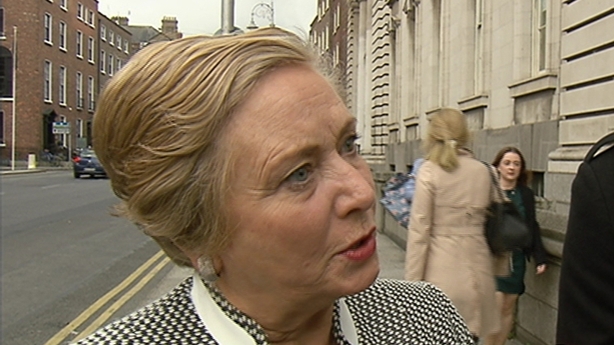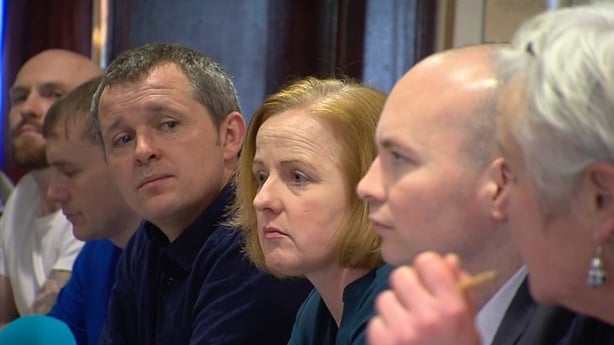Wednesday 15th February 2017
Another Garda whistle-blower demands inclusion of their case in public inquiry
Keith Harrison claims he and his girlfriend endured surveillance and referrals to Tusla?



A second Garda whistle-blower has demanded that his case is included in a public inquiry into an alleged smear campaign against Sgt Maurice McCabe.
Another Garda whistle-blower has demanded that his case is included in a public inquiry into an alleged smear campaign against Sgt Maurice McCabe.
Keith Harrison claims he and his girlfriend endured covert and overt surveillance, referrals to Tusla – the Child and Family Agency, and that they were the victim of rumour, innuendo and malicious falsehoods.
Garda Harrison issued a lengthy statement through his solicitor after Taoiseach Enda Kenny confirmed a tribunal was being set up into the scandal of unfounded and false sex abuse claims being peddled against Sgt McCabe.
Mr Harrison claimed there is an “orchestrated system and culture” among senior management of the force that dictates the treatment of whistleblowers.
Mr Harrison said: “The efforts of this Government to restrict the inquiry/commission of investigation to the very traumatic story of Sgt McCabe absolutely ensures we will not get to the bottom of the culture of management failures and ill-treatment of whistleblowers within An Garda Síochána. ”
Effectively forced
The Government was effectively forced into ordering the tribunal with hearings to be public.
The decision was taken after Mr McCabe and his wife Lorraine said they would not accept any investigation into the controversy being held behind closed doors.
“There’s nothing worse in this country than to be called a sex abuser, nothing worse,” the Taoiseach told the Dáil.
The terms of reference of the tribunal are expected to be finalised in the next 48 hours, with the Government now under deepening pressure to extend it to include other whistle-blowers.
Who is Sgt Maurice McCabe?
In 2008, Sgt Maurice McCabe raised concerns about quashing of penalty points. In 2012, he was banned from using Pulse, the Garda system through which he identified questionable quashing. Controversy over his treatment led to resignations of Garda commissioner Martin Callinan and minister for justice Alan Shatter. In due course, Sgt McCabe was vindicated over his main complaint.
The Garda whistle-blowers: We found this helpful a Yes No
Garda Harrison, who was previously nominated for a Scott Medal for bravery but has been on extended sick leave, was stationed in Athlone when he stopped a colleague on suspicion of drink-driving in 2009.
He also raised concerns about drug-dealing investigations.
In the statement issued on behalf of Mr Harrison and his partner Marisa Simms, their solicitor claimed that since then both he and his family suffered victimisation, bullying, and intimidation.
Disciplinary action?
He has also faced disciplinary action and threatened criminal prosecution.
The officer was prosecuted for having no insurance on his car and he was reported to Tusla.
Garda Harrison has spoken out before and some of his claims have been put on the record in the Dáil.
“It is our belief that senior management within An Garda Síochána set out to attack and destroy our family because I sought to speak out about malpractice within the force,” Mr Harrison said.
“In doing so they tried to discredit me, and also reported ‘concerns’ regarding the wellbeing of my partner’s children, leading to a Tusla investigation, which revealed no risk whatsoever.”
Garda Harrison said his treatment bears similarities to the experience of Sgt McCabe and his family.
“It is clear to us the incidents contained in the disclosures of Supt (David) Taylor and Sgt McCabe are not isolated but rather, along with our experience, identifies a common approach within the senior management of An Garda Síochána to whistleblowers,” Mr Harrison said.
Under pressure
Amid the second whistle-blower going public, the Government is under pressure for Ministers, including the Taoiseach, Tánaiste and Minister for Justice Frances Fitzgerald and Minister for Children Katherine Zappone, to formally explain what they knew and when they knew it, regarding the McCabe affair.
The sergeant was at the centre of an unfounded and false report on a Tusla file of an allegation of sex abuse against a colleague’s daughter.
A counsellor working on behalf of the agency has claimed the error was made when details from a different case were cut and pasted on to a file.
Sgt McCabe has rejected an apology issued by the Health Service Executive at the weekend.
A horrific ordeal?
And in a four-page statement issued on Monday, Sgt McCabe accused Garda Commissioner Noirin O’Sullivan of privately discrediting him while publicly declaring her support over his horrific ordeal.
The officer claimed the Garda chief’s lawyers set out to discredit him at the O’Higgins Commission which investigated and vindicated a series of allegations by Sgt McCabe of negligence in policing in the Cavan-Monaghan district.
Irish Cabinet approves new Irish drink-driving laws



The Cabinet has approved new laws that will automatically ban all those caught drink driving from the roads.
Currently, first-time offenders are not necessarily disqualified and can pay a fine and get three penalty points.
Transport Minister Shane Ross said that this sends out the wrong road safety message.
Welcoming the decision to approve the General Scheme of a Road Traffic (Fixed Penalty – Drink Driving) Bill 2017, Minister Ross said: “The evidence shows that despite a perception to the contrary, drink driving continues to be a very serious issue in this country.
“We can no longer be ambivalent in our attitude toward this destructive practice.”
“What I am now proposing is that the existing provision allowing people to get penalty points rather than a disqualification for drink driving sends the wrong message and should go.
“Instead of three penalty points, such drivers will get a three-month disqualification. This is quite proportionate.
“Drink driving is serious, and potentially fatal. Even a small amount of alcohol can impair people’s reactions, and that cannot be tolerated when people are behind the wheel of a car.”
The Minister expressed his hope that this Bill can be passed quickly and without amendment.
Minister Ross added: “It is important to get it out there and working, and with it the message that drink driving will no longer be without serious consequences.
“This is an important step on the road to enacting what will be a focused, timely and urgently needed piece of legislation which will ultimately save lives.”
The General Scheme will now be submitted to the Office of the Parliamentary Counsel for formal drafting, with a view to its publication as soon as possible.
In line with Government policy, the Minister will also refer the General Scheme to the Joint Oireachtas Committee on Transport, Tourism and Sport for its consideration.
New Irish tenancy laws confuse both the tenants and landlords



The Planning and Development (Housing) and Residential Tenancies Act 2016, announced before Christmas, aimed to bring a greater level of predictability to the rental market. However, confusion remains for both tenants and landlords.
Housing Minister Simon Coveney last month announced an extension of the existing list of rent pressure zones (RPZs). The list now includes most of Galway City as well as 23 smaller commuter towns, including Cork City suburbs such as Douglas and Ballincollig.
While tenants will welcome the new measures in a climate of rapidly rising rents, many landlords see them as curtailing their potential rental income and their ability to manage their properties.
What does it mean if I live in a RPZ?
For those properties now located within a RPZ, rent rises are capped at 4% per year for three years. There is also a set formula which landlords must use when calculating the reviewed rent. This cap doesn’t apply if the property was vacant (before the current new letting), and was not let at any time in the 24 months before the area became an RPZ. The cap also won’t apply where there has been a substantial change in the nature of the accommodation since the rent was last set. For example, if major refurbishment works have been undertaken which would change the market rent applicable for that property.
How often will landlords be able to review rents?
The Residential Tenancies Amendment Act 2015 had restricted a landlord’s ability to review rents to once every two years, so many tenants may now be confused as to when their rent can next be reviewed. The new legislation means that, in the case of existing tenancies within RPZs, the cap on rent rises will apply when the next rent review falls. So, if you are currently within a rent review freeze, the RPZ designation will become relevant once those two years are up. When that next review occurs, rent reviews will then be allowed annually, rather than every two years.
What happens when I have rented a property for six months or more?
Once you have lived in a property for more than six months, a part 4 tenancy occurs, entitling you to remain for a further three-and-a-half years. This right is separate to any lease agreement with the landlord, so even if you have a one-year lease, after six months, you also have part 4 tenancy rights. After four years, if you remain in the property, a further part 4 tenancy begins.
The landlord can only terminate a part 4 tenancy on certain specific grounds, for example, if they require the property for their own use, for that of a family member, or if they plan to substantially refurbish the property.
Two main changes have been introduced to give tenants greater security of tenure.
The first is the extension of the cycle from four to six years, for tenancies that began after December 24, 2016. For any part 4 tenancy beginning before that date, a four-year cycle remains but, as soon as that ends, the further part 4 tenancy will be a six-year cycle.
The second change relates to how a part 4 tenancy can be terminated. Previously, once the first cycle was up, a landlord was entitled to terminate the tenancy at any time in the first six months of the further part 4 tenancy, without needing to fall within one of the above termination grounds.
That six-month window has now been removed. For all tenancies, which began after December 24, 2016, once the further part 4 tenancy commences, the stated reason for termination must also be one as set out in the legislation. This is expected to be extended shortly, to tenancies which commenced on or before that date.
Landlords who wish to avoid having to give specific grounds will need to time the termination correctly so that it falls before a further part 4 tenancy begins.
To achieve this, they will have to serve notice before the current part 4 tenancy ends, with the notice period expiring on, or after, the tenancy’s end-date. This ensures that a further part 4 tenancy does not occur.
Anything else that we should know?
A further provision, which has not yet commenced, is a restriction on landlords seeking to terminate tenancies on the grounds of “intention to sell”. This is where they propose to sell ten or more units within the same development, either at the same time or within a six-month period. This will be of interest given recent media attention around “vulture funds” buying up loans from banks. As they now wish to sell off properties they hold as security, these vulture funds are serving notices on multiple tenants within the same development of “intention to sell”.
Landlords will soon only be able to rely on these grounds if they can prove that selling the property with the tenant still remaining will reduce the market value by 20% below what it would be, if sold with vacant possession. They also need to prove it would cause undue hardship on the landlord.
Irish Water reveals households wasting less than it was previously thought
Managing director Jerry Grant: 765m litres a day still being lost in public pipe network



Metering is said to have identified that “by far the most beneficial gain” in Irish Water’s activities was in fixing leaks “on the public side” of the pipe network.
Information gathered from the State’s water-metering programme has led Irish Water to conclude households waste less water than previously thought.
Jerry Grant, managing director of Irish Water, told the Oireachtas Committee on the future of water charges the utility was “forced to rethink” its calculations on water usage, after the metering programme revealed individual water use was about 110 litres per day, at the lower end of international comparisons.
It had previously been estimated that individuals used in excess of 140 litres per day, but metering had identified that “by far the most beneficial gain” in Irish Water’s activities was in fixing leaks “on the public side” of the pipe network.
Mr Grant told the committee on Tuesday that domestic meters measured “flow” to households “for a variety of uses”, but he said “it was a government decision to charge” for that water.
Drinking water supply?
He said Irish Water provided about 1.7 billion litres of drinking water to homes and businesses a day. Of this, 600 million litres were consumed by households and 300 million litres went to “non-domestic” premises.
He said these figures were dwarfed by the 765 million litres a day which were still being lost in the public pipe network – about 45% of overall water production.
The use of domestic meters had already identified leaks of 77 million litres per day on the householder’s property, which had been fixed under the utility’s free “first fix scheme”.
Already conserving water?
The data the company had got from 800,000 water meters had shown most households were already conserving water – but one per cent of households used over 20% of all domestic water. Five% of households accounted for use of one third of domestic water supplies.
Mr Grant said metering had helped the utility establish that some households had “continuous night flows”, which indicated leaks.
Some 28,000 homes had availed of the utility’s free “first fix” scheme, resulting in savings of 70 million litres of water per day.
He said about a half a billion euro had been spent on domestic water meters when the scheme was suspended, and the remaining fund of about €150 million had been redirected to invest in the network, largely in new connections.
One domestic leak under a driveway could typically see consumption rise to that of 20 households, he said.
“The information is telling us the fundamental gain is about fixing leaks,” Mr Grant said.
He added the greatest gains in water conservation over the next 15 to 20 years will not be from individual household conservation measures, but in fixing leaks and installing district meters.
Mr Grant was asked by Anti Austerity Alliance TD Paul Murphy why water meters were used to gather information on households, while district networks used other tools, from “listening sticks” to technology, to establish water flow.
Mr Grant said Irish Water could gather data from 80,000 meters in two months, collecting by the use of technology-equipped vans, whereas to send out individuals to seek access to individual properties and stopcocks would take a multiple of that time.
A lust for life and why sex is better in your 80’s
Sexually active older people are considered a curiosity, but a new survey suggests that lovemaking is often more fulfilling for ‘sexual survivors’ than those in middle age



Dr David Lee says ‘sexual survivors’ are probably ‘the healthiest people in older age’.
Dr David Lee, a research fellow at Manchester University’s School of Social Sciences, calls them “sexual survivors” – people over the age of 80 who still enjoy an active sex life. In a report written with Professor Josie Tetley, using data from the English Longitudinal Study of Ageing, he notes that while physical challenges (erectile difficulties, for instance) occured more frequently with age, the emotional side of sex appeared more fulfilling for people over 80. Men and women in this age bracket reported more shared sexual compatibility and emotional closeness than those in their 50s, 60s and 70s – which sounds like good news for anyone going through a drought in middle age.
Sex isn’t defined by penetration, says Lee – some older people find more imaginative ways to keep their sex lives active. “We saw quite a lot of adaptation in the older people, saying they no longer had penetrative sexual intercourse and were more content with kissing and cuddling and general intimacy. We kept a very broad definition of sex. We saw what appeared to be adaptive behaviour in the older members of our sample.”
Don’t bank on hitting your sexual peak so late, though. The problem is, having a sex life at all in your 80s is far from guaranteed. Only about one in 10 women aged 85 or older, and nearly one-quarter of men of that age, enjoy one. “They’re a minority, clearly, but they’re an interesting minority,” says Lee. “Among those who were [sexually active], it was quite interesting that they seemed happy with their sexual lives.”
Lee is studying what it takes to become a sexual survivor. There is likely to be a range of factors, he says. Having a partner is important, of course, and many people in their 80s have been widowed. “I would envisage that these [sexual survivors] are the healthiest people in older age,” he adds. Medication, for instance, can interfere with sex drive and ability.
Sexually active octogenarians are still considered such a curiosity that documentaries are made about them (such as Channel 5’s Party Pensioners, which featured an octogenarian burlesque dancer, and Sex and the Silver Gays, a film about older gay men who go to sex parties). Sites aimed at millennials run interviews with them, too – in 2015, Vice published an interview with an 82-year-old called Chris Wilson about his exploits on Grindr (he said he found the hook-up app “especially helpful when travelling. When I was in London, England, I got hit on by about 40 guys. I had sex eight times in seven days!”).
Lee says we need to get used to the idea that some older people may want a fulfilling sex life – and take seriously the means to allow them to achieve this. “We’re simply trying to broaden the discussion around sex and saying, irrespective of age, there is a need for joined-up healthcare services that people can access if they wish. We’re seeing from the comments in our survey [that] when older people try to access healthcare [for] sexual problems they have come across dismissal: ‘You should expect it at your age.’” But Lee has also seen how it becomes internalised in older people: “They think: ‘It’s not relevant to me anymore.’” Better, instead, to know you could enjoy a later-life sexual peak.
First live birth evidence in a group of dinosaur relatives found
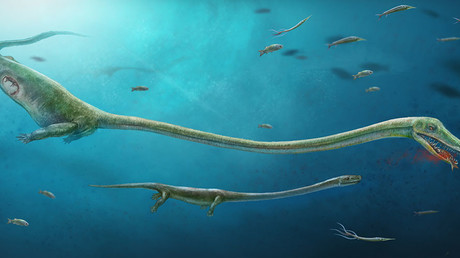

It was adapted for a fully aquatic lifestyle
Scientists have uncovered the first evidence of live births in the group of animals that includes dinosaurs, crocodiles and birds.
All examples of this group, known as the Archosauromorpha, lay eggs.
This led some scientists to wonder whether there was something in their biology that prevented live births.
But examination of the fossil remains of a very long-necked, 245 million-year-old marine reptile from China revealed it was carrying an embryo.
Jun Liu, first author of the new study in Nature Communications, said that the animal would have measured between three and four metres long, with a neck that was about 1.7m long.
The embryo may have been around half a metre long and is positioned inside the rib cage of the adult Dinocephalosaurus fossil, which was discovered in 2008 in Luoping County, Yunnan Province in southern China.
Researchers had to consider whether the smaller animal might have been part of the adult’s last meal. But it’s facing forward, whereas swallowed prey generally face backwards because predators consume the animal head first to help it go down the throat.fossil embryo appears to be facing forwards; ingested prey often end up facing backwards
Another line of evidence in favour of the live birth idea is that the small reptile inside the mother is clearly an example of the same species.
Co-author Prof Mike Benton, from the University of Bristol, told BBC News that the fossil was important because the Archosauromorpha form one of three large groupings of land-based vertebrates (backboned animals), each including about 10,000 species.
Since we now know that no fundamental biological barrier to live births exists in this group, palaeontologists would be “looking very closely” at other fossils. He suggested one target would be a group of aquatic crocodile relatives – whose mode of reproduction was not well known.
Prof Liu, from Hefei University of Technology in China, said the discovery pushes back evidence of reproductive biology in the archosauromorphs by 50 million years.
The mode of reproduction in Dinocephalosaurus also points to how the sex of its offspring was determined.
Co-author Prof Chris Organ, from Montana State University, added: “Some reptiles today, such as crocodiles, determine the sex of their offspring by the temperature inside the nest.
“We identified that Dinocephalosaurus, a distant ancestor of crocodiles, determined the sex of its babies genetically, like mammals and birds.”
Prof Benton explained: “This combination of live birth and genotypic sex determination seems to have been necessary for animals such as Dinocephalosaurus to become aquatic.
“It’s great to see such an important step forward in our understanding of the evolution of a major group coming from a chance fossil find in a Chinese field.”
The possibility that an eggshell once surrounded the embryo but was not preserved in fossilisation could not be ruled out, said Prof Benton. But living Archosauromorphs all lay eggs very early in embryonic development, whereas this embryo is very advanced, with well developed bones.
Furthermore, the team says Dinocephalosaurus’s long neck and other features of its anatomy suggest it could not have manoeuvred easily out of the water, meaning a reproductive strategy like that of turtles – which lay eggs on land before returning to the water – was probably not an option.




